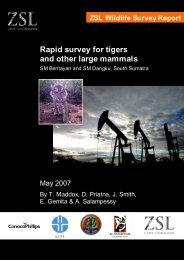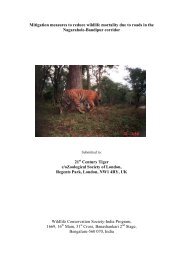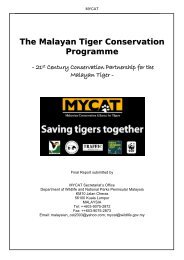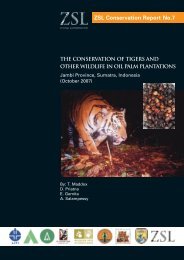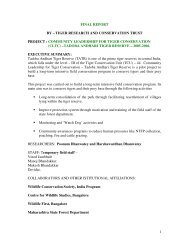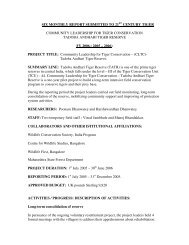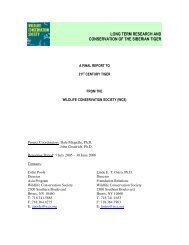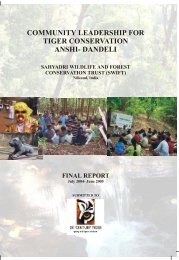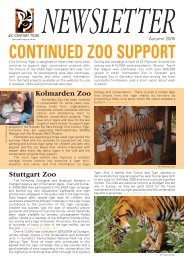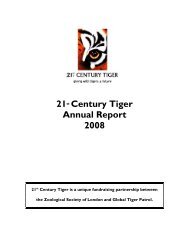CLTC Tadoba Andhari final report 2005 - 21st Century Tiger
CLTC Tadoba Andhari final report 2005 - 21st Century Tiger
CLTC Tadoba Andhari final report 2005 - 21st Century Tiger
Create successful ePaper yourself
Turn your PDF publications into a flip-book with our unique Google optimized e-Paper software.
FINAL REPORT<br />
BY – TIGER RESEARCH AND CONSERVATION TRUST<br />
COMMUNITY LEADERSHIP FOR TIGER CONSERVATION (<strong>CLTC</strong>) –<br />
TADOBA ANDHARI TIGER RESERVE – 2004-<strong>2005</strong>.<br />
PROJECT TITLE:<br />
Community Leadership for <strong>Tiger</strong> Conservation – <strong>Tadoba</strong> <strong>Andhari</strong> <strong>Tiger</strong> Reserve<br />
EXECUTIVE SUMMARY:<br />
<strong>Tadoba</strong> <strong>Andhari</strong> <strong>Tiger</strong> Reserve (TATR) is one of the prime tiger reserves in central India,<br />
which falls under the level – III of the <strong>Tiger</strong> Conservation Unit (TCU) – 44. Community<br />
Leadership for <strong>Tiger</strong> Conservation – <strong>Tadoba</strong> <strong>Andhari</strong> <strong>Tiger</strong> Reserve is a one-year pilot<br />
project to build a long-term intensive field conservation program to conserve tigers and<br />
their prey base.<br />
This project was carried out to build a long-term intensive field conservation program. Its<br />
main aim was to conserve tigers and their prey base through the following activities<br />
Long-term consolidation of the park through facilitating resettlement of villages<br />
lying within the tiger reserve.<br />
Improve protection system through motivation and training of the field staff of the<br />
state forest department.<br />
Monitoring and ‘Watch Dog’ activities and<br />
Community awareness programs to reduce human pressures like NTFP collection,<br />
poaching, fire and cattle grazing.<br />
During the <strong>report</strong>ing period the project leaders worked on mobilizing community support<br />
and improving of protecting system activities.<br />
A total of 48 meetings were held with villagers from the 3 villages due for rehabilitation.<br />
These meetings were held to assist the villagers in understanding the resettlement<br />
package and the new Rehabilitation Act. As a member of the Relocation Monitoring<br />
Committee, formal and informal meetings were held with officials from government<br />
agencies, elected representatives and community leaders to co-ordinate the<br />
implementation of the rehabilitation project and also to build community support for the<br />
project. A Relocation seminar was organised for facilitating the work.<br />
The Relocation project has <strong>final</strong>ly gathered momentum and the first village will be<br />
resettled by March 2006.<br />
1
The project leaders carried out meetings with forest department staff to discuss various<br />
problems related to the reserve.<br />
Insurance against death and disablement has been provided for the third year to 28<br />
frontline field staffs that are not covered under government insurance schemes.<br />
Motivational rewards have been given to 9 field staff and 1 other individual for<br />
exemplary protection work. Community awareness programs were also carried out under<br />
the project to educate general public and students about the conservation of the reserve.<br />
The project leaders participated in two State level Wildlife research seminars to decide<br />
about the statewide research to be carried out to facilitate conservation and protection of<br />
the wild species.<br />
The project leaders also carried out extensive field surveys to map the reserve and to map<br />
the Survey analysis for dependency of the peripheral villages was done in 6 villages.<br />
Field training camps were held in <strong>Tadoba</strong> <strong>Andhari</strong> to train the field staff in wildlife field<br />
management. The project leaders held a GIS / GPS mapping training camp in the<br />
adjoining Melghat <strong>Tiger</strong> Reserve to train the Range officers in the use of the GPS.<br />
PROJECT PERSONNEL:<br />
Overall project guidance: Dr. K. Ullas Karanth, Wildlife Conservation Society.<br />
Project co-ordination: Poonam Dhanwatey<br />
Project leaders: Harshawardhan and Poonam Dhanwatey<br />
Project staff: Five temporary field staff :-<br />
Vinod Jambhule<br />
Mukesh Bhandakkar<br />
Dr. A.D Kholkute (veterinary doctor)<br />
Manoj Bhandakkar<br />
Adik (camp cook)<br />
COLLABORATORS AND OTHER INSTITUTIONAL AFFILIATIONS:<br />
I. Wildlife Conservation Society, India Program, Bangalore: Scientific guidance<br />
II. Centre for Wildlife Studies, Bangalore: Scientific guidance<br />
III. Maharashtra Forest Department: Deputy Conservator of Forests, <strong>Tadoba</strong> <strong>Andhari</strong><br />
<strong>Tiger</strong> Reserve<br />
IV. Wildlife First, Bangalore: Conservation partner<br />
V. Feral, Bangalore, GIS mapping guidance.<br />
PROJECT DURATION: July 01 2004 - June 30 <strong>2005</strong>.<br />
APPROVED BUDGET : GBP 13540 -00<br />
2
DESCRIPTION OF ACTIVITIES :<br />
Long-term consolidation of the reserve through resettlement of the villages from<br />
within the <strong>Tiger</strong> reserve.<br />
In pursuance of the proposed voluntary rehabilitation project, the project leaders and the<br />
staff held 48 formal and informal meetings with the villagers of the two villages, Kolsa<br />
and Botezari (in the field and in the office of TRACT) to address their apprehensions<br />
about rehabilitation. The villagers were also informed about the benefits and<br />
compensation packages of this project. The villagers of two villages were taken to the<br />
Relocation site 5 times and explained the planning of their agricultural and residential<br />
area.<br />
Several formal meetings with forest and other government agencies were held in<br />
connection with the rehabilitation project. A relocation seminar was held in July where in<br />
the Project authorities of the Forest and the Revenue department were invited along with<br />
the villagers from the 3 villages due for relocation. All apprehensions of the villagers<br />
were sorted out and the authorities committed to a time frame to the project. This one day<br />
seminar has helped in giving momentum to the project and was held to plan and coordinate<br />
the implementation of the proposed project and to assist with any shortcomings<br />
in the project.<br />
A group of villagers due to be relocated were taken to Melghat <strong>Tiger</strong> Reserve, from<br />
where 3 villages have been relocated successfully in the recent past. They were shown<br />
the relocation site and had a meeting with the relocated villagers form Melghat.<br />
The project leaders have held 26 meetings with the Principle Secretary, Revenue &<br />
Forest, and the staff of the Secretary, Rehabilitation, in Mumbai and locally to decide on<br />
the quantum of land to be allotted to the landless and the landlords. It was only due to<br />
these consistent meetings of the project leaders with the officials, that this Government<br />
Resolution was announced.<br />
This particular Relocation is the first to be carried out after the government has made a<br />
Rehabilitation Act in 2001. So, all Government resolutions pertaining to this Relocation<br />
will be valid for all such project, which will be done in the State in future. This relocation<br />
will be a model for all these projects.<br />
Field visits to the Relocation site have resulted in an increase in the capacity of the lake,<br />
which is being made to fulfil the needs of the villagers.<br />
The Relocation of the first village will be completed by March 2006, as promised by the<br />
authorities.<br />
Improving protection system<br />
3
The project leaders carried out 29 field visits to <strong>Tadoba</strong> <strong>Andhari</strong> during the <strong>report</strong>ing<br />
period. Meetings with field staff and meetings with senior forest department officials<br />
were held to discuss various conservation and protection problems of the area.<br />
The field staffs of TRACT are in the field 6 days a week. Their work involves monitoring<br />
the entire Tier reserve, visiting the villagers to be relocated and visiting the Relocation<br />
site to check the progress of the work.<br />
The ‘TRACT Wildlife Conservation Award <strong>2005</strong>’award function was held in the<br />
presence of the senior state level forest officials, and the Honourable Forest Minister of<br />
Maharashtra State was the chief guest for this function.<br />
To motivate the field staff awards (Binoculars and wrist watches) have also been given to<br />
9 frontline staff for carrying out meritorious protection duties. 1 Range officer of <strong>Tadoba</strong><br />
was felicitated with field equipment for the water management and protection work he<br />
did in <strong>Tadoba</strong> during his tenure here.<br />
To support the field protection staff insurance against life and disability insurance has<br />
been provided for the third time to 28 staff under the project. This staffs have not been<br />
covered under any government insurance schemes. This insurance cover will act as<br />
moral support for the frontline field staff during carrying out their protection duties<br />
The project leaders also carried out extensive field surveys to map the reserve using<br />
Geographical Positioning System (GPS). The features included areas of impact by<br />
extraction.<br />
Impact maps have been made by the project leaders with three years of data collected<br />
during daily monitoring by the field staff using a GPS. 500 waypoints were taken to<br />
access Extraction of bamboo and timber, illegal fishing, Snares found, trespassers and<br />
domestic dogs seen, fires, grazing, encroachments, cattle kills, human kills, cattle kill<br />
poisoning for retaliation by villagers, human population etc.<br />
This data was then categorised in 6 broad categories and impact assessment maps were<br />
prepared. These maps give a very clear picture of the areas, which are being hammered<br />
and also state the relation between the human population and the anthropogenic pressures<br />
exerted on the <strong>Tiger</strong> reserve.<br />
TRACT has temporarily employed a retired Veterinary doctor, who had been working<br />
with the wildlife department. The project leaders held 3 field-training camps for the entire<br />
staff of <strong>Tadoba</strong> <strong>Andhari</strong>. The training included tranquillisation methods, caring for the<br />
wildlife during summer months, checking water bodies for urea poisoning, identifying<br />
scat, pellets, dung and tracks, foot patrolling methods, caring for wireless and the battery<br />
sets, identifying ill animals in different seasons etc. Printed matter was also given to each<br />
field staff. These camps have been appreciated by the authorities and wish to be repeated<br />
on a regular basis. The other two State <strong>Tiger</strong> Reserve officials have also requested the<br />
project leaders to hold such training camps in their areas.<br />
4
To further boost protection, local intelligence network in the villages within and on the<br />
periphery of the park is being developed through motivational rewards.<br />
Monitoring and ‘watch dog’ activities -<br />
The field staff of TRACT are in the field on a daily basis, and their tracking skills have<br />
been put to use by the authorities as well to patrol problem areas.<br />
Number of incidences of illegal activities has been brought to the notice of the concerned<br />
authorities due to the field monitoring activities of the TRACT field staff and the project<br />
leaders. A number of cases have been registered against offenders by the authorities as<br />
per information given by TRACT.<br />
ACKNOWLEDGEMENTS:<br />
The project team thank the donors, 21 st <strong>Century</strong> <strong>Tiger</strong>.<br />
The project team also thanks the Chief Wildlife Warden of Maharashtra, Reserve Warden<br />
and all the staff of the <strong>Tadoba</strong> <strong>Andhari</strong> <strong>Tiger</strong> Reserve.<br />
The project team wishes to thank Centre for Wildlife Studies for their guidance<br />
throughout the project and to Feral for their guidance and assistance in the GIS mapping<br />
done.<br />
PROBLEMS :-<br />
The accommodation used by the project leaders and field staff, since the last two years<br />
had been allotted by the authorities for the entire year and at the official rate. But the<br />
authorities have asked the staff of TRACT to vacate the premises and book the guest<br />
rooms as and when needed. This will hamper the daily work of the field staff, as guest<br />
rooms at times are unavailable due to tourist pressures.<br />
GOALS / ACTIVITIES FOR NEXT YEAR -<br />
1. Continue conservation monitoring on the periphery of the <strong>Tiger</strong> Reserve.<br />
2. Pursue the voluntary rehabilitation project, do a relocation workshop and help<br />
maintain the decide time frame for the project.<br />
3. Organize another four-day survey for the data collection of the dependency<br />
survey of 4 more peripheral villages.<br />
4. Continue the GPS mapping for impact maps on the periphery of the Reserve.<br />
4. Conduct survey to ascertain density indices.<br />
5. Motivating the field staff by organizing the TRACT Awards ceremony, and by<br />
giving them incentives.<br />
6. Conduct wildlife educational activities in the peripheral villages and those inside<br />
the reserves.<br />
6. Conduct field training camps for the staff of TATR.<br />
7. Organise intelligence network in more peripheral areas of TATR.<br />
8. Work towards getting peripheral areas under the <strong>Tiger</strong> reserve.<br />
5




